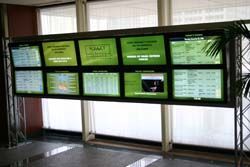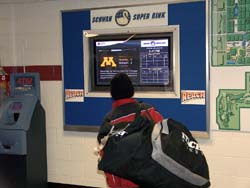- Digital signage is not limited to the world of retail with malls and convenience stores being the most visible. In fact, the largest percentage of digital signage business is not in retail, rather in corporate, transportation, government, education, entertainment/sports, and even churches. Looking at digital signage as a communication tool and not just as an advertising medium opens a whole vista of possibilities.
A young hockey player looks at his game schedule at the Schwan Super Rink in Blaine, MN, where Broadside installed digital signage content software.
One of the most complex and perhaps intimidating parts of the digital signage is the process part of the equation, and perhaps this is where some of the aversion to the segment on the part of the commercial AV community may well come into play. In short, digital signage is made up of content, distribution and management software, networking, the display, and integration at the various locations. The area that is the most difficult to wrap our arms around is content. This is normally far removed from what the typical commercial AV designer or integrator does on a daily basis but ends up being the driving factor in many digital signage applications. The good news is that the client may be the content provider or if not, the company you are working with typically has their own ad agency or marketing department that will be taking care of the creative part leaving the infrastructure to the AV integrator.
The remaining issues to consider in digital signage are management and distribution software, system networking, and ultimately the selection and integration of the displays. At this point our regular readers will expect a long dissertation on displays extolling the virtues of LCD and plasma displays but not this time. The bottom is that the image on screen is the conduit of the message to the mind's eye. There is nothing more important than the direct impact of the display but the truth is that Samsung, Panasonic, Pioneer, NEC, LG, Sharp, Toshiba, Westinghouse, and others have suitable displays that will all do a wonderful job of providing a colorful impact on the viewer. The real differentiators end up being the content and the management and distribution software which determine the success or failure of a digital signage installation.
Software At The Source
While the topic of management and distribution software may at first glance sound rather boring, just the opposite is true. A lot of profound work is going on in the trenches of software developers as they try to meet the ever-growing applications and needs of the digital signage world. The results of their hard work show up in the areas of distribution of content, management, archiving of data, and even verification that content has been displayed. What the software does and how it does it completes the picture that we are trying to achieve. As you can imagine there are all varieties of software providers from the major players like Scala all the way down to niche companies like Nuva. Rather than attempting the impossible task of writing a full overview of companies like the current "800-pound gorilla" Scala, or CoolSign, BroadSign, Omnivex, Wirespring, Web Pavement, etc. I have reviewed three examples of software offerings that demonstrate how a software package can meet the client's requirements.
Let's begin with the release of BroadSign Suite 5.0 in the summer of 2006. They finally resolved the advertising industry's concerns over accountability in digital signage. It plays back media content and provides proof-of-play reports. Users of the latest version of BroadSign's network management software can tell precisely how many times each ad was played on each screen. Proof of performance reports will then compare achieved exposures against the planned ones, so advertisers will not be billed for the ads not delivered due to a technical problem. The new software version takes into account the business hours, holidays and days off at each location, and will turn off screens when a location is closed.
Other features enable advertisers to target their campaigns according to demographic and geographic criteria. Network operators will have complete flexibility in how to configure their network and which criteria to assign to each screen, area, site, location, or market. For instance, a pharmaceutical ad may be directed selectively to only those supermarket screens that have pharmacies, or a print cartridge ad can be targeted to the screens near printer sections. In another example, MP3 player ads can be scheduled to the areas in shopping malls frequented by 21-35 year olds with medium-to-high income.

The Hyatt Regency Chicago provides its guests with a wall of information with Omnivex's digital signage software.
Omnivex is a company that offers a unique approach to digital signage. Omnivex Content Management software is a family of products that lets you assemble, schedule, deliver, and playback dynamic content onto your display network using standard file formats and protocols without the need for expensive proprietary hardware. Omnivex Control 4 manages all available device functions from a central location and all functions can be scheduled to automatically occur from a central location. Omnivex DataPipe 3 acquires and distributes data across a network, allowing multiple users to access and share internal data and messages.
The real story here is that its software permits the operator to control and monitor remote devices and to acquire and distribute real time data from multiple sources. Live data allows you to build intelligence into your display solution, allowing players to automatically react to external conditions in real time. The concept of handling real time data also leads into one of the most interesting potentials in the digital signage world, and that is interactivity. As the hero in The Graduate was asked to remember one word, "plastics," we are asking you to remember one word, and that is "interactivity."
The last digital signage software solution that I want to share with you is Samsung's MagicNet X. Before you begin to yell at me for talking about a display, please relax. The display just happens to be attached to a neat entry-level digital signage software package. At first glance, it does not appear to have applications to digital signage. It looks like a software package dedicated to sharing information to the display from a PC, for pictures, videos, sound, and document files. In reality, MagicNetX has a broad, basic application as an entry-level digital sign application for corporate educational, entertainment, as well as small retail applications. The PC software connects the display into an overall network, allowing a user to schedule all manner of content to display on the screen at desired times. The software can control a single screen, or many screens. Content can be scheduled to run at any time, on any screen. New content is easily added and scheduled. This is an excellent, user friendly, entry into digital signage software and, yes, it is connected to a very nice display.
Statistics
When digital signage first came onto the scene a few short years ago, there was no way to quantify it in terms of return on investment or impact on the marketplace or even consumers. When the brainstorm of a good idea relating to digital signage reached the CFO, more often than not the concept met with a blank stare and a curt comment like: "show me the metrics and the return!" This has not totally changed but over the last couple of years we do have a significant amount of market data to look at.
According to the latest market research, there was over $800 million invested in digital signage in 2005 and this will increase to over $2 billion this year with a forecast of over $4 billion by 2011. If we look at the commercial audiovisual industry as a whole doing $20 billion worldwide in 2005, digital signage represents a significant number. Research postulates that by the end of 2007, over half the retailers in America will deploy some form of digital signage. This is driven by three factors. First of all, exit interviews in retail environments have shown that the consumer is three to four times more attracted to a moving image than a static display. Secondly, they show a 20 percent improvement in assimilation and retention of the information displayed on the "video sign." Last but certainly not least, research shows as much as a 40 percent improvement in sales on the high end and more than a 15 percent increase on the low end as a "worst case" scenario.
From the consumer point of view there are some significant statistics to consider. For example, there is a 45 percent increase in brand awareness due to digital signage and consumer purchases were tracked at an average increase of 30 percent when exposed to digital signage versus static signs.
Over 35 percent of respondents claim that a "video image" affected their purchase decision and nearly 80 percent felt that this type of advertising/information was helpful. In exit interviews, people spoke of an enhanced experience and that this type of exposure would result in repeat business.
Enough with the numbers, suffice it to say that digital signage works from numerous perspectives and this can be shown clearly to even the most skeptical CFO.
Hopefully we have cleared up some issues and reduced some of the confusion and apprehension about digital signage but the story is much bigger than this. More than anything else, our goal is to make you hunger for more information and to delve deeper into the digital signage market. At $2 billion and growing rapidly, it is the elephant in the room that we cannot ignore.










